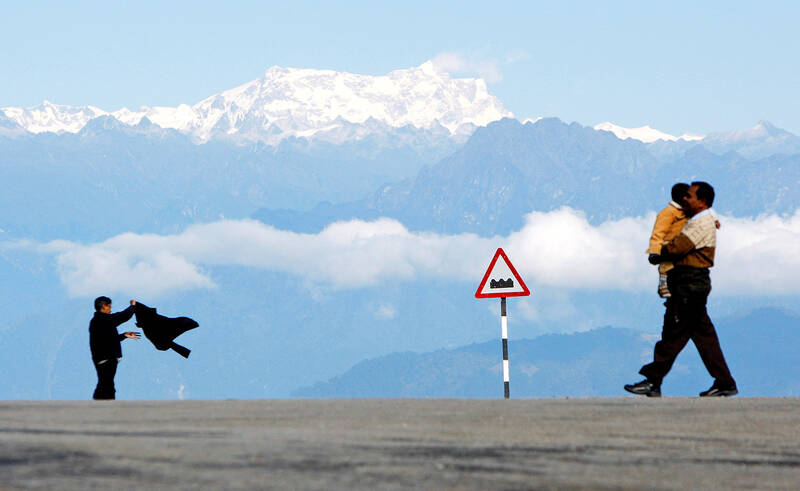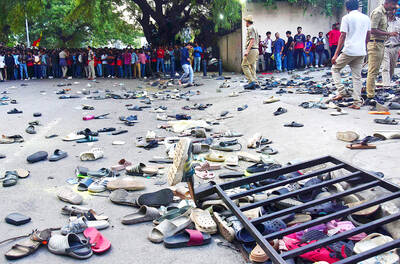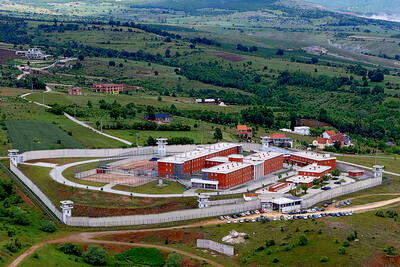Twenty-nine runners yesterday set off on a rare high-altitude race in Bhutan to highlight the dangers of climate change to the Himalayan kingdom sandwiched between China and India, two of the world’s biggest polluters.
Bhutan — which is about the size of Switzerland — has forests covering 70 percent of its land, which absorb nearly three times more climate-changing emissions than the country produces a year.
“The race is designed to raise awareness about climate change and its risks to our economy and the livelihood of the people,” Bhutanese Minister of Foreign Affairs Tandi Dorji said by telephone after flagging off the race in the northwestern town of Gasa.

Photo: Reuters
Organizers said the runners would take five days to complete the 203km Snowman Race from Gasa to the northeastern town of Chamkhar along a trail that normally takes trekkers up to 20 days.
South Asia’s only carbon-
negative country, with a population of fewer than 800,000 people, is vulnerable to the effects of climate change, which is speeding up the melting of its glaciers, and causing floods and unpredictable weather patterns.
Pakistan, at the western end of the Himalayas, has this year been hit by unprecedented flooding caused by unusually heavy rain and faster runoff from its glaciers. Its government and the UN have blamed climate change.
The racers from 11 countries — including the US, Germany, Japan, Tanzania and Bhutan — are to run at an average altitude of 4,500m, with a high point of 5,470m.
The route will take them through diverse terrain from subtropical jungle to fragile, high-altitude ecosystems, with diverse flora and fauna, as well as people and cultures.
“I’ve probably completed maybe around 30 ultramarathons, but never like this,” US runner Sarah Keyes told the state-run Bhutan Broadcasting Service.
“It will be somewhat of an unknown going to that high of an altitude, but I do feel good overall, physically,” Keyes said.

Packed crowds in India celebrating their cricket team’s victory ended in a deadly stampede on Wednesday, with 11 mainly young fans crushed to death, the local state’s chief minister said. Joyous cricket fans had come out to celebrate and welcome home their heroes, Royal Challengers Bengaluru, after they beat Punjab Kings in a roller-coaster Indian Premier League (IPL) cricket final on Tuesday night. However, the euphoria of the vast crowds in the southern tech city of Bengaluru ended in disaster, with Indian Prime Minister Narendra calling it “absolutely heartrending.” Karnataka Chief Minister Siddaramaiah said most of the deceased are young, with 11 dead

By 2027, Denmark would relocate its foreign convicts to a prison in Kosovo under a 200-million-euro (US$228.6 million) agreement that has raised concerns among non-governmental organizations (NGOs) and residents, but which could serve as a model for the rest of the EU. The agreement, reached in 2022 and ratified by Kosovar lawmakers last year, provides for the reception of up to 300 foreign prisoners sentenced in Denmark. They must not have been convicted of terrorism or war crimes, or have a mental condition or terminal disease. Once their sentence is completed in Kosovan, they would be deported to their home country. In

DENIAL: Musk said that the ‘New York Times was lying their ass off,’ after it reported he used so much drugs that he developed bladder problems Elon Musk on Saturday denied a report that he used ketamine and other drugs extensively last year on the US presidential campaign trail. The New York Times on Friday reported that the billionaire adviser to US President Donald Trump used so much ketamine, a powerful anesthetic, that he developed bladder problems. The newspaper said the world’s richest person also took ecstasy and mushrooms, and traveled with a pill box last year, adding that it was not known whether Musk also took drugs while heading the so-called US Department of Government Efficiency (DOGE) after Trump took power in January. In a

LOST CONTACT: The mission carried payloads from Japan, the US and Taiwan’s National Central University, including a deep space radiation probe, ispace said Japanese company ispace said its uncrewed moon lander likely crashed onto the moon’s surface during its lunar touchdown attempt yesterday, marking another failure two years after its unsuccessful inaugural mission. Tokyo-based ispace had hoped to join US firms Intuitive Machines and Firefly Aerospace as companies that have accomplished commercial landings amid a global race for the moon, which includes state-run missions from China and India. A successful mission would have made ispace the first company outside the US to achieve a moon landing. Resilience, ispace’s second lunar lander, could not decelerate fast enough as it approached the moon, and the company has